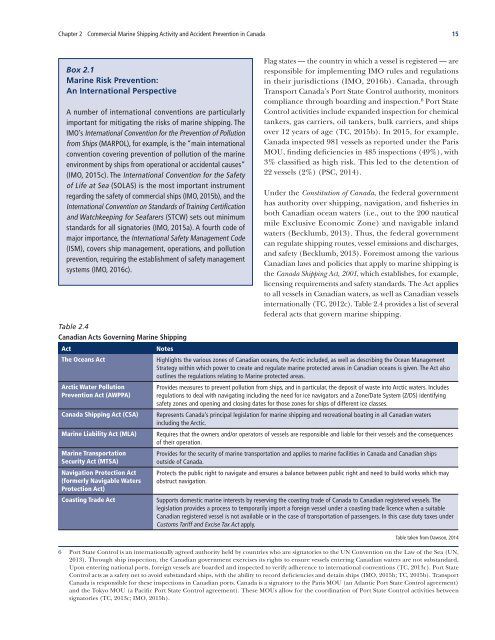Commercial Marine Shipping Accidents Understanding Risks Canada
cca_marine_shipping_risks_en_fullreport
cca_marine_shipping_risks_en_fullreport
Create successful ePaper yourself
Turn your PDF publications into a flip-book with our unique Google optimized e-Paper software.
Chapter 2 <strong>Commercial</strong> <strong>Marine</strong> <strong>Shipping</strong> Activity and Accident Prevention in <strong>Canada</strong><br />
15<br />
Box 2.1<br />
<strong>Marine</strong> Risk Prevention:<br />
An International Perspective<br />
A number of international conventions are particularly<br />
important for mitigating the risks of marine shipping. The<br />
IMO’s International Convention for the Prevention of Pollution<br />
from Ships (MARPOL), for example, is the “main international<br />
convention covering prevention of pollution of the marine<br />
environment by ships from operational or accidental causes”<br />
(IMO, 2015c). The International Convention for the Safety<br />
of Life at Sea (SOLAS) is the most important instrument<br />
regarding the safety of commercial ships (IMO, 2015b), and the<br />
International Convention on Standards of Training Certification<br />
and Watchkeeping for Seafarers (STCW) sets out minimum<br />
standards for all signatories (IMO, 2015a). A fourth code of<br />
major importance, the International Safety Management Code<br />
(ISM), covers ship management, operations, and pollution<br />
prevention, requiring the establishment of safety management<br />
systems (IMO, 2016c).<br />
Table 2.4<br />
Canadian Acts Governing <strong>Marine</strong> <strong>Shipping</strong><br />
Act<br />
Notes<br />
The Oceans Act<br />
Highlights the various zones of Canadian oceans, the Arctic included, as well as describing the Ocean Management<br />
Strategy within which power to create and regulate marine protected areas in Canadian oceans is given. The Act also<br />
outlines the regulations relating to <strong>Marine</strong> protected areas.<br />
Arctic Water Pollution<br />
Prevention Act (AWPPA)<br />
<strong>Canada</strong> <strong>Shipping</strong> Act (CSA)<br />
<strong>Marine</strong> Liability Act (MLA)<br />
<strong>Marine</strong> Transportation<br />
Security Act (MTSA)<br />
Navigation Protection Act<br />
(formerly Navigable Waters<br />
Protection Act)<br />
Coasting Trade Act<br />
Flag states — the country in which a vessel is registered — are<br />
responsible for implementing IMO rules and regulations<br />
in their jurisdictions (IMO, 2016b). <strong>Canada</strong>, through<br />
Transport <strong>Canada</strong>’s Port State Control authority, monitors<br />
compliance through boarding and inspection. 6 Port State<br />
Control activities include expanded inspection for chemical<br />
tankers, gas carriers, oil tankers, bulk carriers, and ships<br />
over 12 years of age (TC, 2015b). In 2015, for example,<br />
<strong>Canada</strong> inspected 981 vessels as reported under the Paris<br />
MOU, finding deficiencies in 485 inspections (49%), with<br />
3% classified as high risk. This led to the detention of<br />
22 vessels (2%) (PSC, 2014).<br />
Under the Constitution of <strong>Canada</strong>, the federal government<br />
has authority over shipping, navigation, and fisheries in<br />
both Canadian ocean waters (i.e., out to the 200 nautical<br />
mile Exclusive Economic Zone) and navigable inland<br />
waters (Becklumb, 2013). Thus, the federal government<br />
can regulate shipping routes, vessel emissions and discharges,<br />
and safety (Becklumb, 2013). Foremost among the various<br />
Canadian laws and policies that apply to marine shipping is<br />
the <strong>Canada</strong> <strong>Shipping</strong> Act, 2001, which establishes, for example,<br />
licensing requirements and safety standards. The Act applies<br />
to all vessels in Canadian waters, as well as Canadian vessels<br />
internationally (TC, 2012c). Table 2.4 provides a list of several<br />
federal acts that govern marine shipping.<br />
Provides measures to prevent pollution from ships, and in particular, the deposit of waste into Arctic waters. Includes<br />
regulations to deal with navigating including the need for ice navigators and a Zone/Date System (Z/DS) identifying<br />
safety zones and opening and closing dates for those zones for ships of different ice classes.<br />
Represents <strong>Canada</strong>’s principal legislation for marine shipping and recreational boating in all Canadian waters<br />
including the Arctic.<br />
Requires that the owners and/or operators of vessels are responsible and liable for their vessels and the consequences<br />
of their operation.<br />
Provides for the security of marine transportation and applies to marine facilities in <strong>Canada</strong> and Canadian ships<br />
outside of <strong>Canada</strong>.<br />
Protects the public right to navigate and ensures a balance between public right and need to build works which may<br />
obstruct navigation.<br />
Supports domestic marine interests by reserving the coasting trade of <strong>Canada</strong> to Canadian registered vessels. The<br />
legislation provides a process to temporarily import a foreign vessel under a coasting trade licence when a suitable<br />
Canadian registered vessel is not available or in the case of transportation of passengers. In this case duty taxes under<br />
Customs Tariff and Excise Tax Act apply.<br />
Table taken from Dawson, 2014<br />
6 Port State Control is an internationally agreed authority held by countries who are signatories to the UN Convention on the Law of the Sea (UN,<br />
2013). Through ship inspection, the Canadian government exercises its rights to ensure vessels entering Canadian waters are not substandard.<br />
Upon entering national ports, foreign vessels are boarded and inspected to verify adherence to international conventions (TC, 2013c). Port State<br />
Control acts as a safety net to avoid substandard ships, with the ability to record deficiencies and detain ships (IMO, 2015h; TC, 2015b). Transport<br />
<strong>Canada</strong> is responsible for these inspections in Canadian ports. <strong>Canada</strong> is a signatory to the Paris MOU (an Atlantic Port State Control agreement)<br />
and the Tokyo MOU (a Pacific Port State Control agreement). These MOUs allow for the coordination of Port State Control activities between<br />
signatories (TC, 2013c; IMO, 2015h).


